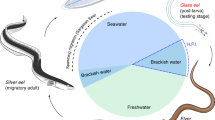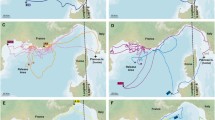Abstract
The migration pattern of silver eel (Anguilla anguilla L.) in the Baltic is well documented from many tagging experiments. This particular investigation differed from previous taggings in that the background of all the eels used was the same. They came from a 1980 stocking programme and had been imported from France as glass eels. When migrating these stocked eels missed the outlet of the Baltic and continued in a south-westerly direction. They were still reported in this southern-most area more than 4 yr later. Indigenous eels turn northwards after passing the south of Sweden and leave the Baltic through the narrow Sound. Since the formerly stocked eels had never been in the Baltic, the absence of an imprinted olfaction cue may explain their orientation failure. Although lacking an imprinted olfaction cue eels were recaptured mainly in a very restricted area in the southwestern Baltic. This reflects another cue, genetic or imprinted during the Atlantic journey. This second cue, temperate, can also serve as the trigger which causes eels to stop migrating and to initiate spawning. The enclosed Baltic acts as a giant trap for eels from the huge stocking programmes undertaken there. As a consequence stocked eels probably contribute little to spawning stocks in the Sargasso Sea which may have contributed to the decrease in abundance of glass eels reported from western Europe in recent decades.
Similar content being viewed by others
Literature cited
Ask, L., Erichsen, L. (1976). Blankålsmärkningar vid svenska Östersjökusten 1941–1968. Meddn Havsfiskelab. Lysekil 199: 1–117 (In Swedish)
Bock, K.-H. (1971). Monatskarten des Salzgehaltes der Ostsee. Dt. hydrogr. Z Erg. H 12: 1–147
Ciepielewski, W. (1976). The size, sex and age of seaward migrating eel from two Masurian lakes. Int. Counc. Explor. Sea (EIFAC) Symp. Eel Res. Mgmt 33: 1–12
Døving, K. B., Westerberg, H., Johnson, P. B. (1985). Role of olfaction in the behavioral and neural responses of Atlantic salmon,Salmo salar, to hydrographic stratification. Can. J. Fish. aquat. Sciences 42: 1658–1667
Erichsen, L. (1976). Statistik över ålyngeluppsamling i svenska vattendrag. Inform. Inst. Freshwat. Res., Drottningholm 8: 1–36 (In Swedish)
Filuk, J. (1984). Eel from the Vistula Firth its past, present and future state. Biul. Morsk. Inst. Ryb. 3–6: 13–18
Filuk, J., Wiktor, J. (1988). Management of eel stocks in the Vistula and Szczecin lagoons in the light of the process of eel stocking. Biul. Morsk. Inst. Ryb. 5–6: 36–44
Hain, J. H. W. (1975). The behaviour of migratory eels,Anguilla rostrata, in response to current, salinity and lunar period. Helgoländer wiss. Meeresunters 27: 211–233
Hessle, C. (1929). De senare årens fiskmärkningar vid svenska Östersjökusten. Medd. Lantbruksstyr. 278: 25–38. (In Swedish)
Karlsson, L. (1984). Migration of European silver eels,Anguilla anguilla. Ph. D. Thesis Acta univ. Upsal., Uppsala univ., Uppsala 745: 1–13
Karlsson, L., Bartel, R., Tesch, F.-W. (1988). Migration and orientation of tagged silver eels released in the southeastern Baltic. Int. Counc. Explor. Sea Comm. Meet (Anadromous and Catadromous Fish Committee) M: 17
Lenz, W. (1971). Monatskarten der Temperatur der Ostsee. Dt. Hydrogr. Erg. H 11: 1–148
Leopold, M. (1976). Stocking as a main factor determining the level of eel catches in Poland. Int. Counc Explor Sea (EIFAC) Symp. Eel Res. Mgmt 14: 1–13
Määr, A. (1947). Über die Aalwanderung im Baltischen Meer auf Grund der Wanderaalmarkierungsversuche im Finnischen und Livischen Meerbusen in den Jahren 1937–1939. Medd. Statens Unders. Försöksanstalt. Sötvattenfisk, Drottningholm 27: 1–56
McCleave, J. D., Kleckner, R. C., Castonguay, M. (1987). Reproductive sympatry of American and European eels and implications for migration and taxonomy. Am. Fish. Soc. Symp. 1: 286–297
Moriarty, C. (1986). Elver catches in European rivers 1938–1985. Int. Counc. Explor. Sea Cann Meet (Anadromous and Catadromous Fish Committee) M:17
Rasmussen, C. J. (1951). Two Danish finds of female eel (Anguilla anguilla) in spawning or partial spawning dress. Rep. Dan. biol. Stn 53:36–39
Stasko, A. B., Rommel, S. A. (1974). Swimming depth of adult American eels (Anguilla rostrata) in a salt water bay as determined by ultrasonic telemetry. J. Fish. Res. Bd Can. 31: 1148–1150
Svärdson, G. (1949). Eels (Anguilla anguilla) found in Sweden in partial nuptial dress. Rep. Inst. Freshwat. Res. 29: 129–134
Svärdson, G. (1976). The decline of the Baltic eel population. Rep. Inst. Freshwat. Res. 55:136–143
Teichmann, H. (1959). Über die Leistung des Geruchssinnes beim Aal (Anguilla anguilla L.). Z. vergl. Physiol. 42: 206–254
Tesch, F.-W. (1974). Influence of geomagnetism and salinity on the directional choice of eels. Helgoländer wiss. Meeresunters 26: 382–395
Tesch, F.-W. (1979). Tracking of silver eels (Anguilla anguilla) in different shelf areas of the northeast Atlantic. Rapp. P.-v. Réun. Cons. perm. int. Explor. Mer 174: 104–114
Tesch, F.-W. (1983). Der Aal: Biologi und Fischerei Vol. 2 Aufl. Parey, Hamburg und Berlin
Tesch, F.-W. (1986). Changes in swimming depth and direction of silver eels (Anguilla anguilla L.) from continental shelf to deep sea. Int. Counc. Explor. Sea Comm. Meet. (Anadromous and Catadromous Fish Committee) M: 18
Tesch, F.-W., Westerberg, H., Karlsson, L. (1989). Tracking studies on migrating silver eels in the central Baltic. Int. Counc. Explor. Sea Comm. Meet. (Anadromous and Catadromous Fish Committee) M: 21
Trybom, F., Schneider, G. (1908). Die Markierungsversuche mit Aalen und die Wanderungen gekennzeichneter Aale in der Ostsee. Rapp. P.-v. Réun. Cons. perm. int. Explor. Mer 9: 51–59
Westerberg, H. (1979). Counter-current orientation in the migration of the European eel. Rapp. P.-v. Réun. Cons. perm. int. Explor. Mer 174: 134–143
Westerberg, H. (1984). The orientation of fish and the vertical stratification at fine and micro-structure scales. In: McCleave, J. D., Arnold, G. P., Dodson, J. J., Neill, W. H. (eds.) Mechanisms of migration in fishes. Plenum, New York, p. 179–203
Westin, L., Nyman, L. (1979). Activity, orientation and migration of Baltic eel (Anguilla anguilla L.). Rapp. R.-v. Réun. Cons. perm. int. Explor. Mer 174: 115–123
Wickström, H. (1986). Growth of cultured eels stocked in two Swedish lakes. Vie Milieu 36: 273–277
Williams, G. C. (1975). Sex and evolution. Princeton University Press, London
Voorhis, A. D. (1969). The horizontal extent and persistence of thermal fronts in the Sargasso Sea. Deep-Sea Res. 16:331–337
Author information
Authors and Affiliations
Additional information
Communicated by T. Fenchel, Helsingør
Rights and permissions
About this article
Cite this article
Westin, L. Orientation mechanisms in migrating European silver eel (Anguilla anguilla): Temperature and olfaction. Mar. Biol. 106, 175–179 (1990). https://doi.org/10.1007/BF01314798
Accepted:
Issue Date:
DOI: https://doi.org/10.1007/BF01314798




